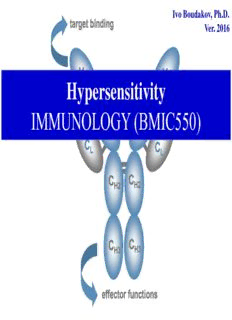
Hypersensitivity IMMUNOLOGY PDF
Preview Hypersensitivity IMMUNOLOGY
Ivo Boudakov, Ph.D. Ver. 2016 Hypersensitivity IMMUNOLOGY (BMIC550) Learning Objectives FYI Topics and keywords to be discussed: Hypersensitivity I, II, III, and IV. Description of Hypersensitivity type V reaction. Rhesus disease (Erythroblastosis fetalis). Autoimmune hemolytic anemia. Idiopathic thrombocytopenia purpura. Cold hem-agglutinin disease. Graves disease. Arthus Reaction. Serum sickness. Glomerulonephritis. Rheumatoid arthritis. Systemic lupus erythematosus (SLE). Tuberculin test. Contact sensitivity 131. List the Gell and Coomb’s classification of hypersensitivity 132. Describe the pathophysiologic mechanisms associated with Type I (IgE)- mediated injury. 133. Compare and contrast the acute phase reaction with the late phase reaction in anaphylaxis. 134. Explain the role of eosinophils in allergic and anaphylactic reaction. 135. Discuss the therapeutic modulation of Type I hypersensitivity. Explain the proposed mechanism underlying “desensitization” (“allergy shots”). 136. Explain the principles underlying the RAST test and skin test. Explain how they can be used as diagnostic tools. 2 Learning Objectives FYI 136. List the categories of intervention for patients susceptible to Type I hypersensitivities. 137. Explain the principle underlying desensitization therapy. 138. Describe allergic asthma.. Describe the bronchial wall changes that occur in asthma. 139. Compare and contrast Type II and Type III hypersensitivity reactions. 140. Compare complement mediated cell lysis and antibody dependent cell cytotoxicity. 141. Compare immunopathology of Goodpasture’s syndrome and SLE. 142. Compare and contrast drug induced Type I and Type II hypersensitivity reactions. 143. Discuss the underlying reasons for the development of Erythroblastosis fetalis. 144. Describe Type IV cell mediated hypersensitivity. 145. Recall the basis for, and examples of, contact hypersensitivity. 146. Explain the principle of, and immunology of a Mantoux test. 147. Describe granulomatous formation. 3 Hypersensitivity Under some circumstances immune system reaction causes tissue and organ damage instead of protection Such reactions are collectively known as hypersensitivity Reaction could occur in two situations: against environmental antigens against self (autologous) antigens which is usually linked to tolerance failure Allergen is an antigen that causes harmful reaction and technically it is linked with type I hypersensitivity. 4 Basic characteristics of Hypersensitivity Reaction is antigen specific Reaction depends on the participation of antibodies or lymphocytes Prior exposure to an antigen is required (sensitization) First contact with an antigen produces no detectable reaction, but sensitizes the immune system Secondary and any other re-exposure to the same antigen elicit the hypersensitive reaction Additional re-exposures to the same antigen may increase or sometimes decrease the sensitivity of the reaction 5 Hypersensitivity - Four (Five) Types Type I (Immediate Hypersensitivity) D E T A IgE mediated reaction such as allergy or anaphylaxis I D E M Type II (Cytotoxic Hypersensitivity) Y D Antibody dependent (IgM or IgG) cytolytic reactions O B I T Type III (Immune Complex Hypersensitivity) N A Immune complex reactions (mediated by IgM or IgG) Type IV (Delayed Hypersensitivity -DTH) cell mediated immunity, such as tuberculin test Type V (Noncytotoxic or Stimulatory Hypersensitivity) same underlining mechanism as type II hypersensitivity (IgG or IgM) but instead of damage it alters tissue activation 6 Type I – Immediate Hypersensitivity Limited number of allergens when deposited in low doses on mucosal epithelial cells or skin trigger mast cells activation Allergens include Pollens, trees, grass, and dust Food allergens Milk, eggs, fish, cereals, nuts Insect bites, mite feces, dogs, cats Reaction against drugs (penicillin) and other haptens, mold spores, etc. 7 Clinical Presentation of Type I Hypersensitivity Wheel and flair – almost immediate vasodilation with infiltrate presenting as wheel and inflammation around Atopic dermatitis (atopic eczema) – itchiness which is not caused by histamines hence anti-histamines would not help with eczema 1/5 infants (due to fragile skin) vs. 1/50 adults develop eczema 8 Clinical Presentation of Type I Hypersensitivity Hives (urticaria) – itchiness linked to histamine release Individual lesions usually do not last longer than 1-2 days healthy lung inflamed airway lung airway Asthma – allergens act on the tracheobronchial tree Inflammation causes edema of the airway wall PENTAX Medical Company. Hyper-secretion of mucus causes airflow obstruction 9 Clinical Presentation of Type I Hypersensitivity Allergic rhinitis: (hay fever) – acts on the mucus membranes of the nose and eye Congestion, itchiness, and sneezing 10
Description: